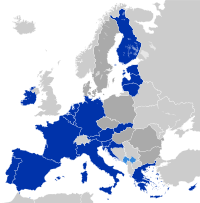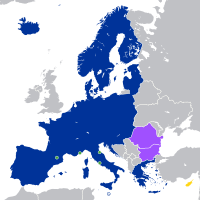Black Wednesday

| Part of a series of articles on |
| UK membership of the European Union (1973–2020) |
|---|
 |
| This article is part of a series on |
 |
|---|
|
|
| ||
|---|---|---|
|
Prime Minister of the United Kingdom
First ministry and term (November 1990 – April 1992)
Second ministry and term (April 1992 – May 1997)
Bibliography
|
||
Black Wednesday, or the 1992 sterling crisis, was a financial crisis that occurred on 16 September 1992 when the UK Government was forced to withdraw sterling from the (first) European Exchange Rate Mechanism (ERM I), following a failed attempt to keep its exchange rate above the lower limit required for ERM participation. At that time, the United Kingdom held the Presidency of the Council of the European Union.
The crisis damaged the credibility of the second Major ministry in handling of economic matters. The ruling Conservative Party suffered a landslide defeat five years later at the 1997 general election and did not return to power until 2010. The rebounding of the UK economy in the years following Black Wednesday has been attributed to the depreciation of sterling and the replacement of its currency tracking policy with an inflation targeting monetary stability policy.[1][2]
Prelude
[edit]When the ERM was set up in 1979, the United Kingdom declined to join. This was a controversial decision, as the Chancellor of the Exchequer, Geoffrey Howe, was staunchly pro-European. His successor, Nigel Lawson, whilst not at all advocating a fixed exchange rate system, nevertheless so admired the low inflationary record of West Germany as to become, by the mid-eighties, a self-styled "exchange-rate monetarist", one viewing the sterling–Deutschmark exchange rate as at least as reliable a guide to domestic inflation – and hence to the setting of interest rates – as any of the various M0-M3 measures beloved of those he labelled as "Simon Pure" monetarists. He justified this by pointing to the dependable strength of the Deutsche Mark and the reliably anti-inflationary management of the Mark by the Bundesbank, both of which he explained by citing the lasting impact in Germany of the disastrous hyperinflation of the inter-war Weimar Republic. Thus, although the UK had not joined the ERM, at Lawson's direction (and with Prime Minister Margaret Thatcher's reluctant acquiescence), from early 1987 to March 1988 the Treasury followed a semi-official policy of "shadowing" the Deutsche Mark.[3] Matters came to a head in a clash between Lawson and Thatcher's economic adviser Alan Walters, when Walters claimed that the Exchange Rate Mechanism was "half baked".[4]
This led to Lawson's resignation as Chancellor; he was replaced by former Treasury Chief Secretary John Major who, with Douglas Hurd, the then Foreign Secretary, convinced the Cabinet to sign Britain up to the ERM in October 1990, effectively guaranteeing that the UK Government would follow an economic and monetary policy preventing the exchange rate between the pound and other member currencies from fluctuating by more than 6%. On 8 October 1990, Thatcher entered the pound into the ERM at DM 2.95 to £1. Hence, if the exchange rate ever neared the bottom of its permitted range, DM 2.773 (€1.4178 at the DM/Euro conversion rate), the government would be obliged to intervene. In 1989, the UK had inflation three times the rate of Germany, higher interest rates at 15%, and much lower labour productivity than France and Germany, which indicated the UK's different economic state in comparison to other ERM countries.[5]
From the beginning of the 1990s, high German interest rates, set by the Bundesbank to counteract inflationary effects related to excess expenditure on German reunification, caused significant stress across the whole of the ERM. The UK and Italy had additional difficulties with their double deficits, while the UK was also hurt by the rapid depreciation of the United States dollar – a currency in which many British exports were priced – that summer. Issues of national prestige and the commitment to a doctrine that the fixing of exchange rates within the ERM was a pathway to a single European currency inhibited the adjustment of exchange rates. In the wake of the rejection of the Maastricht Treaty by the Danish electorate in a referendum in the spring of 1992, and an announcement that there would be a referendum in France as well, those ERM currencies that were trading close to the bottom of their ERM bands came under pressure from foreign exchange traders.[6]
In the months leading up to Black Wednesday, among many other currency traders, George Soros had been building a huge short position in sterling that would become immensely profitable if the currency fell below the lower band of the ERM. Soros believed the rate at which the United Kingdom was brought into the Exchange Rate Mechanism was too high, inflation was too high (triple the German rate), and British interest rates were hurting their asset prices.[7]
The currency traders act
[edit]The UK government attempted to prop up the depreciating pound to avoid withdrawal from the monetary system the country had joined only two years earlier. John Major authorised the spending of billions of pounds worth of foreign currency reserves to buy up sterling being sold on the currency markets. These measures failed to prevent the pound falling below its minimum level in the ERM. The Treasury took the decision to defend sterling's position, believing that to devalue would promote inflation.[8]
Remarks by Bundesbank President Helmut Schlesinger triggered the attack on the pound.[9] An interview of Schlesinger by the Wall Street Journal was reported by the German financial paper Handelsblatt.[10] Schlesinger told the journalist that "a more comprehensive realignment" of currencies would be needed, following a recent devaluation of the Italian lira.[11] On the evening of Tuesday, 15 September 1992, the headline was already circulating. Schlesinger said he thought he was speaking off the record. He later wrote that he stated a fact and this could not have triggered the crisis.[12] This remark hugely increased pressure on the pound leading to large sterling sales.[9][13]
Currency traders began a massive sell-off of pounds on Wednesday, 16 September 1992. The Exchange Rate Mechanism required the Bank of England to accept any offers to sell pounds. However, the Bank of England only accepted orders during the trading day. When the markets opened in London the next morning, the Bank of England began their attempt to prop up their currency, as decided by Norman Lamont, the chancellor of the exchequer, and Robin Leigh-Pemberton, governor of the Bank of England. They began accepting orders of £300 million twice before 8:30 am, but to little effect.[14] The Bank of England's intervention was ineffective because traders were dumping pounds far faster. The Bank of England continued to buy, and traders continued to sell, until Lamont told Prime Minister John Major that their pound purchasing was failing to produce results.[15]
At 10:30 am on 16 September, the British government announced an increase in the base interest rate, from an already high 10%, to 12% to tempt speculators to buy pounds. Despite this and a promise later the same day to raise base rates again to 15%, dealers kept selling pounds, convinced that the government would not keep its promise. By 7:00 pm that evening, Lamont announced Britain would leave the ERM and rates would remain at the new level of 12%; however, on the next day the interest rate was back to 10%.[15]
It was later revealed that the decision to withdraw had been agreed at an emergency meeting during the day between Lamont, Major, foreign secretary Douglas Hurd, president of the Board of Trade Michael Heseltine, and home secretary Kenneth Clarke (the latter three all being staunch pro-Europeans as well as senior Cabinet ministers),[16] and that the interest rate hike to 15% had only been a temporary measure to prevent a rout in the pound that afternoon.[17]
Aftermath
[edit]Other ERM countries such as Italy, whose currencies had breached their bands during the day, returned to the system with broadened bands or with adjusted central parities.[18]
Some commentators, following Norman Tebbit, took to referring to ERM as an "Eternal Recession Mechanism"[19] after the UK fell into recession during the early 1990s. While many people in the UK recall Black Wednesday as a national disaster that permanently affected the country's international prestige, some Conservatives claim that the forced ejection from the ERM was a "Golden Wednesday"[20] or "White Wednesday",[21] the day that paved the way for an economic revival, with the Conservatives handing Tony Blair's New Labour a much stronger economy in 1997 than had existed in 1992[21] as the new economic policy swiftly devised in the aftermath of Black Wednesday led to re-establishment of economic growth with falling unemployment and inflation.[22] Monetary policy switched to inflation targeting.[23][24]
The Conservative Party government's reputation for economic excellence had been damaged to the extent that the electorate was more inclined to support a claim of the opposition of the time – that the economic recovery ought to be credited to external factors, as opposed to government policies implemented by the Conservatives. The Conservatives had recently won the 1992 general election, and the Gallup poll for September showed a small lead of 2.5% for the Conservative Party. By the October poll, following Black Wednesday, their share of the intended vote in the poll had plunged from 43% to 29%.[25] The Conservative government then suffered a string of by-election defeats which saw its 21-seat majority eroded by December 1996. The party's performances in local government elections were similarly dismal during this time, while Labour made huge gains.
Black Wednesday was a major factor in the Conservatives losing the 1997 general election to Labour,[citation needed] who won by a landslide under the leadership of Tony Blair. The Conservatives failed to gain significant ground at the 2001 general election under the leadership of William Hague, with Labour winning another landslide majority. The Conservatives did not take Government again until David Cameron led them to victory in the 2010 general election, 13 years later. Five years later in 2015, the party won its first overall majority 23 years after its last in 1992, five months before the crisis.
George Soros made over £1 billion in profit by short selling sterling.[26]
The cost of Black Wednesday
[edit]In 1997, the UK Treasury estimated the cost of Black Wednesday at £3.14 billion,[27] which was revised to £3.3 billion in 2005, following documents released under the Freedom of Information Act (earlier estimates placed losses at a much higher range of £13–27 billion).[28] Trading losses in August and September made up a minority of the losses (estimated at £800 million) and the majority of the loss to the central bank arose from non-realised profits of a potential devaluation. Treasury papers suggested that, had the government maintained $24 billion foreign currency reserves and the pound had fallen by the same amount, the UK might have made a £2.4 billion profit on sterling's devaluation.[29][30]
See also
[edit]- Impossible trinity – Trilemma in international economics
- 1999–2002 sale of United Kingdom gold reserves
- Sterling crisis (disambiguation), other currency crises in British history
Footnotes
[edit]- ^ McRae, Hamish (10 February 2005). How the ERM disaster turned into a triumph. The Independent. Retrieved 21 October 2019.
- ^ Moore, Charles (3 November 2018). Bring on the next Black Wednesday. The Spectator. Retrieved 21 October 2019.
- ^ "Not while I'm alive, he ain't – Part 4 Thatcher and Lawson". The Westminster Hour. BBC Radio 4. 15 May 2003.
- ^ "Sir Alan Walters". The Daily Telegraph (obituary). 5 January 2009. Retrieved 21 October 2019.
- ^ Bonefeld, Werner; Burnham, Peter (13 January 2006). "1990–1992: Britain and the politics of the European exchange rate mechanism". Libcom. Retrieved 17 January 2024.
- ^ Aykens, Peter (April 2002). "Conflicting Authorities: States, Currency Markets and the ERM Crisis of 1992–93". Review of International Studies. 28 (2). Cambridge University Press: 359–380. doi:10.1017/S0260210502003595. JSTOR 20097797. Retrieved 21 October 2019.
- ^ Mallaby, Sebastian (10 June 2010). More Money Than God: Hedge Funds and the Making of a New Elite. Penguin Press HC. ISBN 9781594202551.
- ^ Bootle, Roger (28 April 2008). "Pound fall is UK's get-out-of-jail-free card". The Daily Telegraph. London, UK. Archived from the original on 1 May 2008.
- ^ a b Alain Naef (30 September 2022). "A small remark with big consequences: what sparked Black Wednesday?". Economic History Society. Retrieved 26 May 2024.
- ^ James, Harold (2020). Making a Modern Central Bank: The Bank of England 1979–2003. Studies in Macroeconomic History. Cambridge: Cambridge University Press. p. 229. ISBN 978-1-108-83501-5.
- ^ Eichengreen, Barry; Naef, Alain (1 September 2022). "Imported or home grown? The 1992–3 EMS crisis". Journal of International Economics. 138: 103654. doi:10.1016/j.jinteco.2022.103654. ISSN 0022-1996.
- ^ Marsh, David; Keegan, William; Roberts, Richard (15 September 2017). Six Days in September: Black Wednesday, Brexit and the making of Europe. OMFIF Press. ISBN 9780995563636.
- ^ Naef, Alain (2022). An Exchange Rate History of the United Kingdom: 1945–1992. Studies in Macroeconomic History. Cambridge: Cambridge University Press. ISBN 978-1-108-83999-0.
- ^ Litterick, David (13 September 2002). "Billionaire who broke the Bank of England". The Telegraph. Retrieved 16 May 2014.
- ^ a b Inman, Phillip (13 September 2012). "Black Wednesday 20 years on: how the day unfolded". The Guardian. Retrieved 21 October 2019.
- ^ "Major's dither cost UK billions, says Lamont". The Independent. 27 September 1999. Retrieved 21 October 2019.
- ^ Johnston, Philip (10 September 2012). "Black Wednesday: The day that Britain went over the edge". The Daily Telegraph. Retrieved 21 October 2019.
- ^ Sevilla, Christina R. Explaining the September 1992 ERM Crisis: The Maastricht Bargain and Domestic Politics in Germany, France, and Britain. Harvard University. Retrieved 21 October 2019.
- ^ Tebbit, Norman (10 February 2005). "An electoral curse yet to be lifted". The Guardian. London, UK. Retrieved 30 December 2008.
- ^ Roger Bootle (15 May 2009). "A strong-arm policy is needed to hold the pound down on the rebound". The Daily Telegraph. London, UK. Archived from the original on 12 January 2022.
- ^ a b Kaletsky, Anatole (9 June 2005). "The reason that Europe is having a breakdown...it's the Euro, stupid". The Times. Archived from the original on 29 May 2010. Retrieved 30 December 2008.(subscription required)
- ^ [1] Archived 16 October 2011 at the Wayback Machine
- ^ "Inflation Targeting Has Been A Successful Monetary Policy Strategy". NBER. Retrieved 31 October 2016.
- ^ "Targeting Inflation: The United Kingdom in Retrospect" (PDF). IMF. Retrieved 31 October 2016.
- ^ "Gallup spreadsheet". Archived from the original on 13 October 2009. Retrieved 28 July 2014.
- ^ Litterick, David (13 September 2002). "Billionaire who broke the Bank of England". The Daily Telegraph. London, UK. Retrieved 24 February 2013.
- ^ Dury, Hélène. "Black_Wednesday" (PDF). Retrieved 24 February 2016.
- ^ Tempest, Matthew (9 February 2005). "Treasury papers reveal cost of Black Wednesday". The Guardian. London, UK. Retrieved 26 April 2010.
- ^ Freeman, Harold. "The Cost of Black Wednesday Reconsidered" (PDF). HM Treasury. p. 4. Archived from the original (PDF) on 3 April 2013. Retrieved 9 October 2018.
- ^ "Guide to the papers and full list of documents". HM Treasury. Archived from the original on 3 April 2013. Retrieved 9 October 2018.
Further reading
[edit]- Budd, Alan. "Black Wednesday-A Re-examination of Britain's Experience in the Exchange Rate Mechanism." IEA Occasional Paper 135 (2005). online
- Bustos, Sebastian, and Martin Rotemberg. "Elasticity Pessimism: Economic Consequences of Black Wednesday." (2017). online
- Gottschalk, Sylvia. "From black Wednesday to Brexit: Macroeconomic shocks and correlations of equity returns in France, Germany, Italy, Spain, and the United Kingdom." International Journal of Finance & Economics 28.3 (2023): 2843-2873. online
- Roberts, Richard Whitfield, William Keegan, and David Marsh. Six days in September: Black Wednesday, Brexit and the Making of Europe (OMFIF Press, 2017). ISBN 9780995563636
- Truman, Edwin M. Economic Policy and Exchange Rate Regimes: What Have We Learned in the Ten Years since Black Wednesday? (LSE Financial Markets Group, 2002). online
- Ward, David. "Black Wednesday 30 years on." (2022). online
- Williams, Ben. "Black Wednesday: thirty years on." Political Insight 13.3 (2022): 22-25. online
External links
[edit]- Black Wednesday, bbc.co.uk. Retrieved 11 January 2017.
- open.edu 24, September 2009 Archived 28 May 2010 at the Wayback Machine, Martin Upton, head of the Centre for Financial Management at The Open University Business School tells Ione Mako about the upside of Black Wednesday.
- Eichengreen, Barry; Naef, Alain (2022). "Imported or Home Grown? The 1992-3 EMS Crisis". Journal of International Economics. Cambridge, MA. doi:10.3386/w29488.
Our analysis focuses on a neglected factor in the crisis: the role of the weak dollar in intra-EMS tensions.







